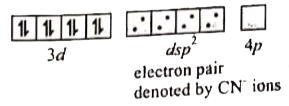Explain as how two complexes [Ni(CN)4]−2 and [Ni(CO)4] have different structures but do not differ in their magnetic behaviour. (Ni-28)
(i)In Ni(CO)4 , nickel is in zero oxidation state. (Ni+2=3d84s2)

E.C of Ni in hybridised state

It is diamagnetic and has a tetrahedral geometry .
(ii)In [Ni(CN)4]−2 , Ni is in +2 oxidation state. Electronic configuration of Ni+2 ion is 3d8 .

CN− ion being a strong liquid and in its presence , the electrons in 3d orbital for hybridisation. Thus , it undergoes dsp2 hybridisation.
Ni+2 in hybridised state

The CN− ions denote a pair of electrons to the valent dsp2 hybrid orbitals . Thus , four Ni− CN bonds are formed .
[Ni−(CN)_4]−2 formation

Thus the geometry is square planar and the complex is diamagnetic .
Topper's Solved these Questions
- CO-ORDINATION CHEMISTRY BOOK - PREMIERS PUBLISHERSCHAPTER - CO-ORDINATION CHEMISTRY EXERCISE - Other Important Question & Answer (Choose the correct Answer)
30 Videos
- CHEMISTRY IN EVERYDAY LIFEBOOK - PREMIERS PUBLISHERSCHAPTER - CHEMISTRY IN EVERYDAY LIFEEXERCISE - OTHER IMPORTANT QUESTIONS& ANSWERS (ANSWER THE FOLLOWING QUESTIONS)
63 Videos
- ELECTRO CHEMISTRYBOOK - PREMIERS PUBLISHERSCHAPTER - ELECTRO CHEMISTRYEXERCISE - OTHER IMPORTANT QUESTIONS & ANSWERS (II. Answer the following questions: )
58 Videos
Similar Questions
Explain how two complexes of nickel, [Ni(CN)4]2− and Ni(CO)4 have different structures but do not differ in magnetic behaviour.
View Solution(a) What is a ligand ? Give an example of a bidentate ligand.
(b) Explain as to how the two complexes of nickel, [Ni(CN)4]2− and Ni(CO)4 have different structures but do not differ in their magnetic behaviour. (Ni = 28)
View Solution
Knowledge Check
The complex ion [Ni(CN)4]2− is :
ASquare planar and diamagneticBTetrahedral and paramagneticCSquare planar and paramagneticDTetrahedral and diamagnetic[Ni(CO)4] and [Ni(NH3)4]2+ do not differ in:
AMagnetic momentBOxidation number of NiCGeometryDEANOut of [Fe(CN)6]4−,[Ni(CN)4]2−, and [Ni(CO)4]: select the incorrect Statement(s):
AAll have identical geometryBAll are paramagneticCall are diamagneticD[Fe(CN)6]4− is dimagnetic but [Ni(CN)4]2− and [Ni(CO)4] are paramagnetic
(a) What is a ligand ? Give an example of a bidentate ligand.
(b) Explain as to how the two complexes of nickel, [Ni(CN)4]2− and Ni(CO)4 have different structures but do not differ in their magnetic behaviour. (Ni = 28)
View SolutionExplain how two complexes of nickel, [Ni(CN)4]2− and Ni(CO)4 have different structures but do not differ in magnetic behaviour.
View SolutionThe two complexes of nickel, [Ni(CN)4]2− and [Ni(CO)4], have different structures but possess same magnetic behaviour. Explain.
View SolutionOut of [Fe(CN)6]4−,[Ni(CN)4]2−, and [Ni(CO)4]: select the incorrect Statement(s):
View SolutionExplain the structure of [Ni(CN)4]2− on the basis of valence bond theory.
View Solution
